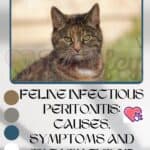Tyzzer’s disease in cats is a rather dangerous bacterial infection that can occur in our feline.

Tyzzer’s disease can affect not only cats and dogs but also other animals such as rats, gerbils, raccoons, horses, hamsters and other rodents.
It is a contagious disease of bacterial origin transmitted through the fecal-oral cycle.
Generally the specimens most affected by this pathology are young cats, which due to severe liver damage cannot survive beyond 24-48 hours.
Let’s see what causes the disease, how we can identify it and how we can treat Tyzzer’s disease in cats.
Causes of Tyzzer’s disease in cats
Tyzzer’s disease in cats is a very serious condition that mainly involves organs such as the liver and intestines.
And the one and only cause that generates this pathology is the bacterium Clostridium piliformis.
This bacterium, belonging to the Clostridiacea family, multiplies in the intestine and once it reaches the liver, causes serious damage.
The genus Clostridium includes obligate anaerobic gram positive bacilli capable of forming spores if environmental conditions are adverse.
These spores can live very long in the surrounding environment (even for years) and are resistant to heat and many disinfectants on the market.
Consequently, it is easy for these to contaminate and infect the soil and then the cat.
That’s why experts recommend removing everything that could cause the infection , especially the feces, and ensuring your cat a healthy , good and balanced diet.
Symptoms

The signals that can be identified are many and can be confused with the scents of many other pathologies.
The symptoms manifested by the cat are:
- low body temperature
- depression
- diarrhea in cats
- abdominal distension
- abdominal pain and discomfort
- liver enlargement
- lethargy
- loss of appetite
It is also possible, however, that Tyzzer’s disease in cats occurs but without symptoms and is thus transferred from one animal to another without being aware of it.
Tyzzer’s disease diagnosis and treatment in cats
In order to make a diagnosis, the veterinarian will perform a physical examination of the cat, accompanied by a complete medical history, as the first visit .
He will then perform routine laboratory tests , such as:
- blood exam completed
- biochemical profile
- electrolyte panel
- urine analysis
It will also be able to carry out the biochemical profile test which is the most important as it can reveal abnormally high levels of liver enzymes, just before the cat’s condition worsens.
These tests will allow the doctor to assess the health of the animal and the severity of the cat’s disease .
Unfortunately, this pathology has a very rapid course and can get out of hand.
The high mortality of the person who contracted the infection within the first ten days is highly probable.
Once the diagnosis has been established, the veterinarian will proceed with relieving the symptoms , as a specific therapy for Tyzzer’s disease in cats has not yet been identified.
In this case, the vet will be able to advise us on how to take care of the cat’s physical, emotional and social needs.
There are, in fact, palliative therapies that totally take care of patients affected by a disease that no longer responds to specific treatments.
Palliative therapies aim to increase comfort and minimize suffering in this case of the cat, during all phases of an incurable disease.
The purpose of this particular form of therapy is to have control over pain and symptoms but also to cure the psychological and social aspect of the animal.
In severe cases, your vet may recommend that you admit your cat to a veterinary facility that has the tools to monitor vital signs.






